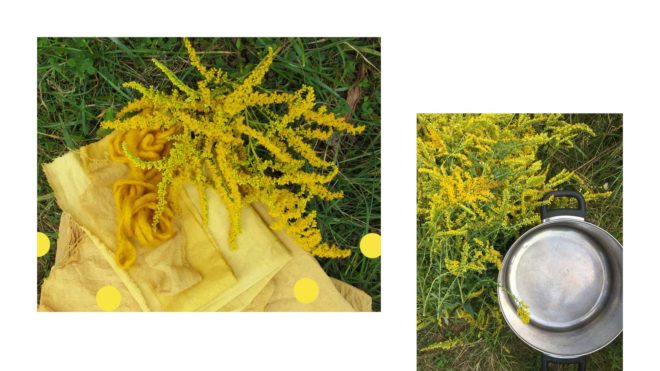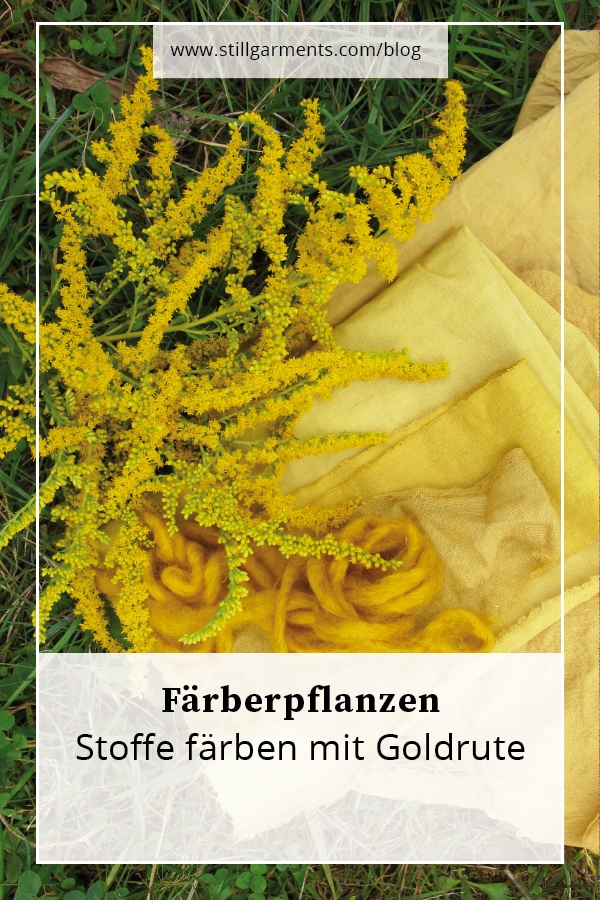Your basket is currently empty!

Dyeing yellow with goldenrod
From late summer onwards it can hardly be overlooked and is in full bloom: The time has come to dye beautiful yellows with goldenrod. Comparing my garden today on September 1st, 2020, with photos from previous years, it probably started to blossom earlier this year than in previous years. But it's still not too late to get your dye pots ready!
Goldenrod is one of the Dye plantsin my garden that just grow without any of my doing. This perennial reproduces through seeds, but also through rhizomes (i.e. underground) and has come to us from our neighboring garden. I harvest it abundantly, and wherever it threatens to take over beds, I dig it up.


Canadian goldenrod is the most common variant here now, Solidago canadensis. Sie gilt als sogenannter Neophyt, wurde also nach 1492 in Europa eingeführt. Der Name lässt es anklingen, sie ist in Nordamerika heimisch. „Neophyt“, eingeschleppte invasive Art, beides klingt erstmal nicht so gut. Aber die Kanadische Goldrute ist nicht in böser Absicht eingewandert, sondern als wurde von Menschen gezielt als Zierpflanze nach Europa gebracht und später auch als Bienenweide gepflanzt. In Deutschland wird sie tatsächlich nur in begrenzten Gebieten als ökologisch problematisch eingeordnet.
Auch wenn sie sich schnell etabliert hat und auch weiter verbreitet, in den meisten Gebieten hat sie laut dem Bundesamt für Naturschutz small impact on endangered species.. Also Entwarnung. (Anders sieht es in Teilen Österreichs aus. Und in der Schweiz steht sie auf der Schwarzen Liste der Neophyten.) Und nicht nur das, die Goldrute ist durchaus wertvoll, in vieler Hinsicht. Sie blüht spät und wird von Insekten umschwirrt, gilt als Heilpflanze – und sie färbt!
Wenn du wildwachsende Pflanzen sammelst, sollte das immer mit Bedacht geschehen, darüber kannst du hier lesen: Foraging for dye plants.
Dyeing with goldenrod
I love to dry and store goldenrod to use in winter, as it is so abundant here. But I have heard from several dyers they don't get as clear yellow tones from dried goldenrod.
Edit: Vielleicht haben durchwachsene Farbergebnisse mit trockener Goldrute auch etwas mit der Wasserqualität zu tun. Mein Berliner Leitungswasser ist einerseits sehr hart, und hat dabei einen neutralen bis minimal alkalischen pH-Wert. Ist dein Wasser sehr weich/sauer, und du hast keinen Erfolg mit dieser Färbepflanze, probiere doch mal Kreide (Calciumcarbonat) zuzusetzen. Hier hat Catherine Ellis über den Zusammenhang von the effect of pH on yellow dyes, I highly suggest to take a look.
Einfach und direkt tolle, leuchtende Gelbtöne färbst du am besten mit frischer Goldrute. Im Vergleich mit anderen gelben Pflanzenfarbstoffen, wie der Färberkamille und dem Färberwau, nehme ich bei der Goldrute eher mehr Pflanzenmaterial für intensive Farbergebnisse. Aber weil sie ja oft eben gleich ziemlich geballt auftritt, ist das kein Problem, solange der Färbetopf groß genug ist!
You can use flowers, flowers and leaves, for dyeing. The former dyes somewhat cleaner tones. When heating the plant matter and when dyeing, I make sure that it doesn't get too hot. If the dye is boiling for a longer period of time, the colour sometimes tends to have a brownish tinge instead of a rich yellow.
As always when dyeing with plants: it's well worth taking your time with it. That begins with preparing fabric or woolen yarn. Pre-mordanting is particularly important on plant fibres such as cotton fabric (it is in general, but especially so with this dye plant). Goldenrod dye takes definitely better to wool and silk - which does not mean that it is not worth experimenting with cotton fabrics!


Here I used as much goldenrod as I could fit in my pot. I didn't weigh any plants or fabric samples - but all fabrics were mordanted beforehand. And again and again I find it exciting to see how different mordants affect the color! I poured water on the flowers and slowly warmed them up and simmered for about two hours. For dyeing I poured everything through a cloth, squeezed out the flowers, and then put fabrics and woolen thread in it. And after the first round, I dyed other fabrics to exhaust the dye bath.


Drying goldenrod for the winter
To store goldenrod, I cut the flowering shoots so that I mainly harvest flowers and a few leaves. If there are already small side shoots, I cut above them so they flower again soon. It is best to harvest the flowers before they have fully opened, otherwise they ripen into fluffy seeds that spread everywhere like tiny parachutes.
To dry them, I hang goldenrod bouquets upside down, or lay them on paper or a lattice. In a dry and shady place, in my case in our garden shed. Once dry, I put them in large paper bags or cloth bags. To save space, you can strip the dry leaves and flowers off the almost woody stems before packing them.
To dye with the stored goldenrod, I first soak the dried plant in cold water overnight before carefully heating them to extract the dye.

Comments
3 responses to “Dyeing yellow with goldenrod”
-
Finde die Idee an sich super – aber wenn man bedenkt, dass die Goldrute im Spätsommer extrem wichtig für Bienen ist, finde ich in dem Fall, dass man sie lieber stehen lassen sollte, als in großem Stil zu sammeln.
-
Liebe Helga,
Ganz wichtiger Punkt, danke! In großem Stil sollte (darf) man Wildpflanzen eh nicht sammeln, da gibt’s ja die Handstraußregelung. Ich mach’s so, dass ich, auch bei der Goldrute, nur ernte, wenn es sehr viel gibt, und zwar so dass es nachher noch unberührt aussieht. Und da ich ja einen Garten hab, ernte ich die auch nur noch hier im hier, wo ich sie in großer Menge wachsen lasse.
-
-
Da Goldruten invasive Pflanzen sind habe ich da keinerlei Bedenken. Bei uns wid sie möglichst aus dem Wald oder von den Bahndämmen entfernt.
Leave a Reply